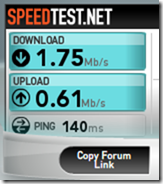I spend about a 5 days a month travelling to various data center events. The rest of the time I work from my home office or meet with people locally. With latest news of Internet being turned off in Egypt and Libya, we take for granted having high speed internet access. But even with a broadband dsl or cable modem, service does go down, and it can be frustrating to figure out whether the problem is in your equipment or the ISP. Especially when you don't have Internet access. My last outage from Comcast cable was a DNS problem at Comcast which made me switch to Google's Public DNS service.
What is Google Public DNS?
Google Public DNS is a free, global Domain Name System (DNS) resolution service, that you can use as an alternative to your current DNS provider.
To try it out:
- Configure your network settings to use the IP addresses 8.8.8.8 and 8.8.4.4 as your DNS servers or
- Read our configuration instructions.
If you decide to try Google Public DNS, your client programs will perform all DNS lookups using Google Public DNS.
When Comcast goes down I fire up my Verizon Mifi 2200 which I use when travelling and driving with the kids and I can give them internet access in the car to stream Netflix.
We're at least a generation away from internet on everything. Until then, the Verizon MiFi 2200 will drive one 3G cellular data connection over Wi-Fi to a handful of gadgets at once.
But, I want to automate the fail over from Comcast to another ISP.
My first choice I was going to to go with, but changed my mind was a Qwest DSL line. At $50 a month for at best 3mbps down and 680 up and bad reviews I didn't like the choice. Until Qwest brings out fiber in my area and extends the range from the central office to my home, I think my performance will be marginal. And, my Mifi 2200 already does 1.5mbps down and 500 up or better.
What I really want to get is the Verizon Mifi 4510 which is the 4G version of the current wireless modem I have with 10X the speed.
Here is Walt Mossberg's review of a Verizon 4G modem.
I disabled Wi-Fi on the ThinkPad, plugged in the LTE modem and ran 10 tests using the popular Speedtest.net website. The results were impressive. Verizon's 4G network averaged just a shade under 16 megabits per second for downloads and 6.6 mbps for uploads. That was 15 times the download speed, and 13 times the upload speed, of a Verizon 3G modem I tested immediately afterward using the same method in the same location.
To relate these speeds to real-world scenarios, I downloaded from iTunes a standard-definition episode of the TV show "The Good Wife"—a 588 megabyte file—in just seven minutes, instead of the two hours or so iTunes predicted it would take when I was using the 3G modem. I streamed several long videos, including two in HD, from the Web, and they played smooth as silk.
The Verizon mifi 4510 should be shipping within the next month.
So, what about automating the backup. I was looking at Dual Wan Routers when I was considering Qwest DSL as a backup. But, when going with the wireless modem as a backup I needed a 3G/4G modem backup. Fortunately, there is a market for these type of devices for branch offices and point of sale locations. The device that makes sense for my needs is a Cradlepoint MBR1200.
MBR1200 - FAILSAFE GIGABIT N ROUTER FOR MOBILE BROADBAND
ALWAYS CONNECTED
The CradlePoint MBR1200 is a robust 802.11n router with 3G/4G failover capabilities. Built for home, small business, branch offices, temporary and remote enterprise environments seeking to implement continuous, always-on connectivity.
With its failover/failback capability, the MBR1200 automatically switches to a secondary connection (either wired or wireless) when your primary service is interrupted. Once your service is restored, the MBR1200 will automatically failback to the primary connection - keeping your business online with minimal interruption to users.
Whether you’re wired or wireless, the MBR1200 Business Series Router keeps your business connected.
As soon as Verizon releases the Mifi 4150, I'll buy the Cradlepoint MBR1200. And write a blog entry on whether I was able to get this to work and simulate losing Comcast Internet access.



